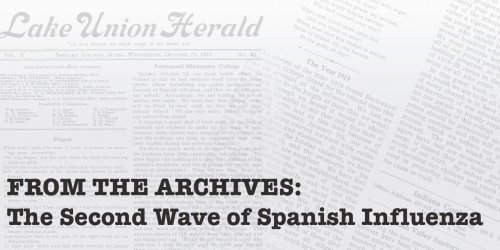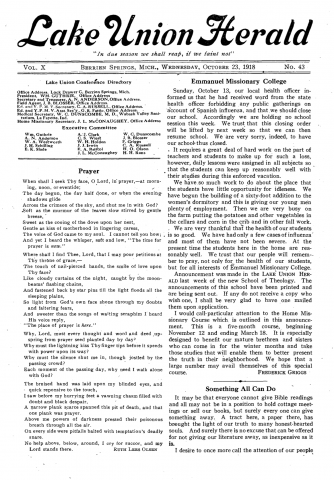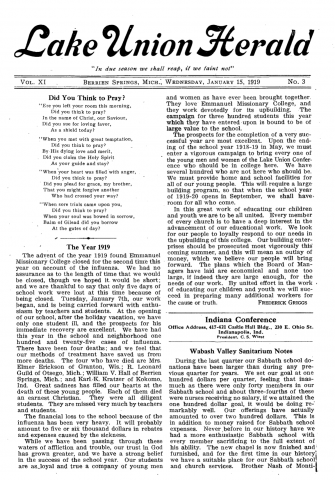
The Spanish Influenza spanned 1918‒1919, killing an estimated 50 million people around the world. This devastating flu virus was caused by an H1N1 virus with genes of avian origin. Previously unknown, the world was defenseless to stop its spread.
According to the CDC, “There were three different waves of illness during the pandemic, starting in March 1918 and subsiding by summer of 1919. The pandemic peaked in the U.S. during the second wave in the fall of 1918. This highly fatal second wave was responsible for most of the U.S. deaths attributed to the pandemic.”

In late October, the Lake Union Herald first reported from Emmanuel Missionary College, known today as Andrews University, that public gatherings would be prohibited due to the spread of the Spanish influenza, which meant school would have to be postponed.
“Sunday, October 13, our local health officer informed us that he had received word from the state health officer forbidding any public gatherings on account of Spanish influenza, and that we should close our school. Accordingly we are holding no school session this week. We trust that this closing order will be lifted by next week so that we can then resume school. We are very sorry, indeed, to have our school thus closed,” Frederick Griggs wrote in the October 23, 1918 Lake Union Herald issue.
Very similar to today’s effect of coronavirus, teachers worked hard to keep their students equipped to continue their studies despite the temporary closing of their school.
As Emmanuel Missionary College closed its doors in hopes of only a temporary closure, many churches across the Lake Union Conference also closed their doors where public meetings were asked to stop temporarily.
“Word comes to us that some of our churches are closing their Sabbath meetings in towns where public meetings of every kind have been discontinued because of the influenza. This is right; and we believe our people should exercise every precaution necessary to assist in ridding the country of this terrible disease,” writes W.H. Holden in the October 23, 1918 Lake Union Herald issue.
It was during this same time that the Lake Union Conference would hear of the first Adventist church member to pass away from the influenza.
“Raymond Kinsey, of Holly, who has been at Camp Custer for the past few weeks, contracted Spanish influenza in camp, and died Sunday morning. Burial was at Holly, October 16. His father, Ben Kinsey, is in a very serious condition. . . .” A week later, W.M. Guthrie writes in the October 30, 1918 Lake Union Herald issue that, “large numbers have died of the influenza.”
As many churches and public gatherings were closed or canceled, C.S. Wiest wrote in the Lake Union Herald October 30, 1918 issue about his visits in the Wisconsin area.
“I hope that during this general epidemic we shall not lose courage in the Lord but that we may worship Him most earnestly in our homes. I would suggest that you hold your Sabbath school in your own home, and not neglect the Sabbath school offering. Keep it in hand until such a time as you can turn it over to the Sabbath school secretary. There is danger of falling short in our offerings during this general epidemic and isolation. We must not come short in our mission funds.”
“Our school has been closed for about two weeks on account of the influenza. At this writing we have seventeen cases in the dormitories, including four of our teachers, besides our principal and our farm manager who live outside the dormitories. A number of our students left for their homes Sunday where they expect to stay until school can be opened again. Although we are sorry that this break has come so suddenly in our work, we are very thankful for the mildness of the disease among us.
“We are all of good courage and know that the Lord will continue to protect us, and ask that all our brethren remember us in prayer,” reports O.P. Wilson of the North Wisconsin Conference.
“Epidemic conditions, affecting to a greater or less extent every conference in the Lake Union, have resulted in the closing of many of our schools in common with the public schools. Emmanuel Missionary College is at this writing, October 31, finishing its third week of enforced vacation. About fifty percent of the student body has returned home awaiting the lifting of the ban.
“Several of our academies have also been closed for a greater or less length of time. In some of these schools there has been no occurrence of the epidemic, and they have been permitted to operate without a break,” wrote C.A. Russell in the Lake Union Herald issue of November 6, 1918.
Russell also reported that while many church schools had closed, teachers were ready to jump back in to educating their community youth at a moment’s notice. Many teachers helped care for the sick, gave out lesson assignments and gave individuals assistance to students as needed. Additionally, medical inspections were implemented which consisted of one of their physicians visiting the schools to make personal examination of each student.

As a new year began, Frederick Griggs reported in January 15, 1919 of the Lake Union Herald issue that the, “The advent of the year 1919 found Emmanuel Missionary College closed for the second time this year on account of the influenza. We had no assurance as to the length of time that we would be closed, though we hoped it would be short; and we are thankful to say that only five days of school work were lost at this time because of being closed. Tuesday, January 7th, our work began, and is being carried forward with enthusiasm by teachers and students. At the opening of our school, after the holiday vacation, we have only one student ill, and the prospects for his immediate recovery are excellent. We have had this year in the school and neighborhood one hundred and twenty-five cases of influenza. There have been four deaths; and we feel that our methods of treatment have saved us from more deaths.
“The financial loss to the school because of the influenza has been very heavy. . . . While we have been passing through these waters of affliction and trouble, our trust in God has grown greater, and we have a strong belief in the success of the school year.”
In that same issue, T.S. Copeland reported that, “the influenza ban has now been lifted in most of our churches and our schools are all now in session. Much time has been lost and most pupils are behind in their work, but we hope to make up what we have lost.”
* * * * *
The Spanish influenza would not end until April 1920. By the end of the pandemic, the virus had infected an estimated 500 million people and killed 50 million worldwide, with 675,000 in the United States.
As of October 6, 2020, the CDC reports an estimated 35.5 million confirmed COVID-19 cases, 24.8 million people have recovered, and there have been 1.04 million deaths worldwide. Out of these confirmed cases, there are an estimated 7.52 million cases and 210,000 deaths in the United States.
Sources
Katie Fellows, Lake Union Communication assistant